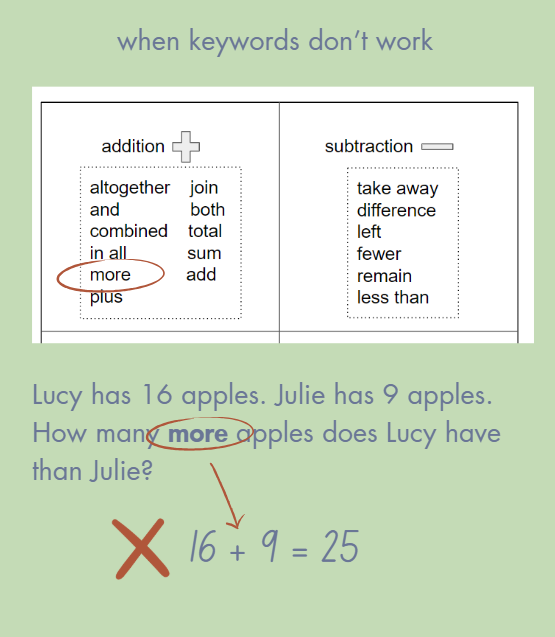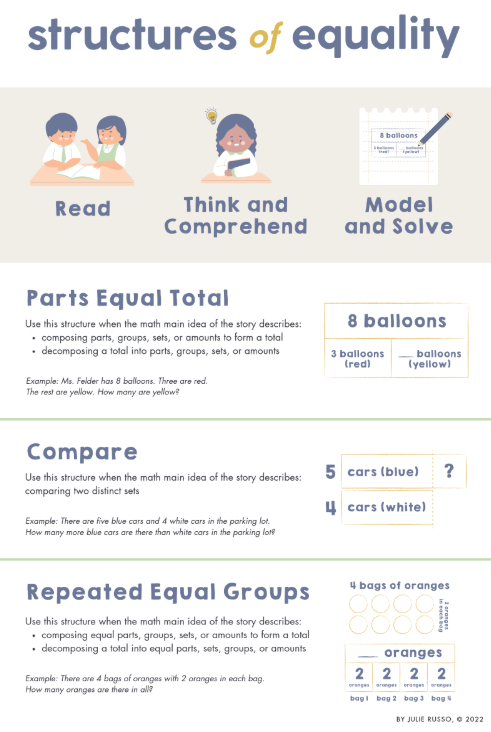April 2, 2025
If you’ve ever watched a student stare blankly at a word problem, you know the struggle is real. Some students don’t even know where to begin, others pick out numbers and guess an operation, and a few just shut down completely. It’s frustrating, for them and for us as teachers.
For years, I tried different strategies to help my students make sense of word problems.I taught them to underline keywords. I encouraged them to ask, “What’s the questionasking me?” But no matter what, I kept running into the same issue: my studentsweren’t actually understanding the relationships between the numbers in the problem.They were searching for clues, not meaning.
That’s why I developed Structures of Equality (SoE), a way to help students truly grasp what’s happening in a problem rather than just hunting for the “right” operation. I started to research why word problems are so difficult, and it confirmed my beliefs around why focusing on comprehension is critical.
Why are word problems so hard for students?
If students struggle with word problems in your classroom, you’re not alone. Research backs up what we see every day.
1. Reading comprehension is a huge barrier.
A 2023 article from Education Week explains that many students struggle with word problems simply because they struggle with reading. If a student can’t fully understand the problem, they won’t be able to solve it, no matter how strong their math skills are.
This makes perfect sense. Word problems are reading problems as much as they are math problems. If students don’t understand the scenario, they won’t know what to do with the numbers.
This is also why I refer to them as number stories. It helps students to make sense when they realize there’s a context, just like in a regular story.
2. Keywords can lead students astray.
For years, we’ve told students that certain words, like “altogether” or “left”, are signals for addition or subtraction. But research from Powell, Namkung, and Lin (2022) shows that keywords don’t actually help students develop real understanding. Instead, students memorize shortcuts without thinking critically about the situation.
And let’s be honest—keywords can be misleading. The word total might mean addition in some problems, but not always. If a student relies on keywords rather than meaning, they’ll end up with incorrect answers more often than not.

3. Students default to “just doing something with the numbers”
Robert Kaplinsky’s How Old is the Shepherd? problem exposes a big issue in math instruction: students often grab numbers and do something with them, even when the problem doesn’t make sense.
In his study, Kaplinsky asked students, “There are 125 sheep and 5 dogs in a flock. How old is the shepherd?” A shocking number of students gave numerical answers like “130” or “25” because they assumed they had to perform a calculation. This highlights a major problem: many students see math as a series of operations to perform, not as a way to make sense of relationships.
How do we help students think structurally?
So, if keywords and guesswork don’t work, what does? Research suggests we should be focusing on visualization and structural thinking.
1. Learning from Singapore Math
Singapore consistently ranks as one of the top-performing countries in math, and a big reason is its focus on understanding before calculation. Instead of rushing students into operations, Singapore Math encourages them to use visual models, like bar models, to represent relationships between numbers.
This aligns directly with Structures of Equality. When students can see the relationship in a problem, they’re much more likely to understand what to do next.
2. Why SoE is more powerful than a bar model alone
Bar models are a great tool, but they have a limitation: students can draw them without truly understanding the problem. I saw this happen in my own classroom. Students would correctly draw a bar model but still struggle to explain what was happening in the story.
SoE takes visualization a step further by explicitly requiring students to define the relationships in a problem.
- Instead of just drawing, students must label and justify their thinking.
- They identify the math main idea and then choose which structure (Parts Equal Total, Compare, or Repeated Equal Groups) best represents the situation as it’s occurring in the story.
- They represent equality explicitly.

In short, a bar model is a tool, but SoE is a framework. It ensures that students don’t just go through the motions of drawing a model. They develop a deep understanding of how numbers and relationships work together.
What happens when we shift to SoE?
Structures of Equality changes the way students approach math. Instead of panicking when they see a number story, they slow down, analyze the relationships, and choose a strategy that makes sense. They stop guessing and start thinking.
Most importantly, SoE levels the playing field. Students who might struggle with reading or who feel left behind in math suddenly have access to a framework that makes sense. They gain confidence, and their problem-solving skills improve.
A call to action for educators
If you’ve ever felt like word problem instruction was broken, you’re not alone. The research backs up what we’ve all seen: students need more than keywords and tricks. They need tools that help them truly understand math.
SoE is my answer to this problem. Let’s move away from shortcuts and toward real mathematical thinking. Let’s make math stories make sense for every student.